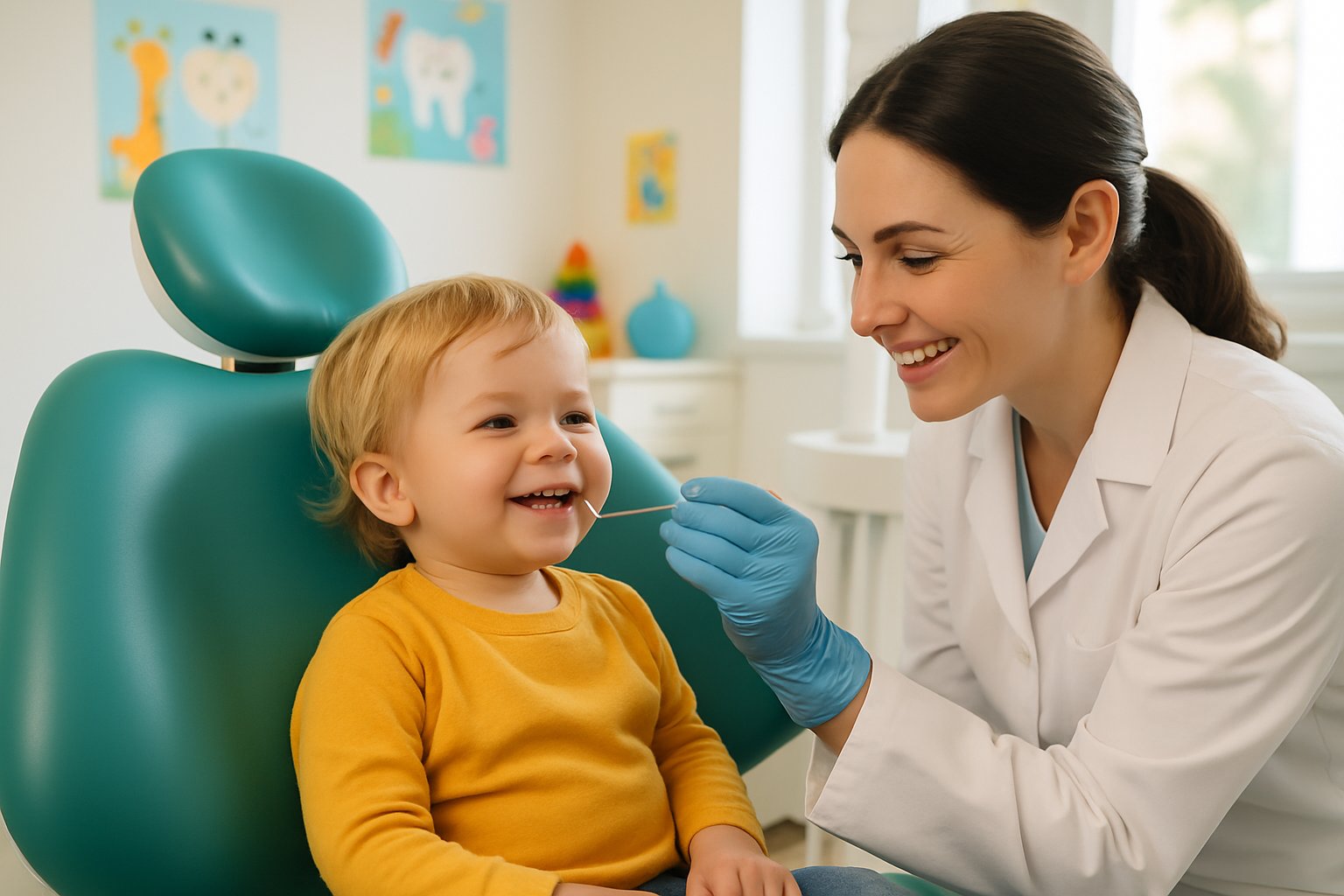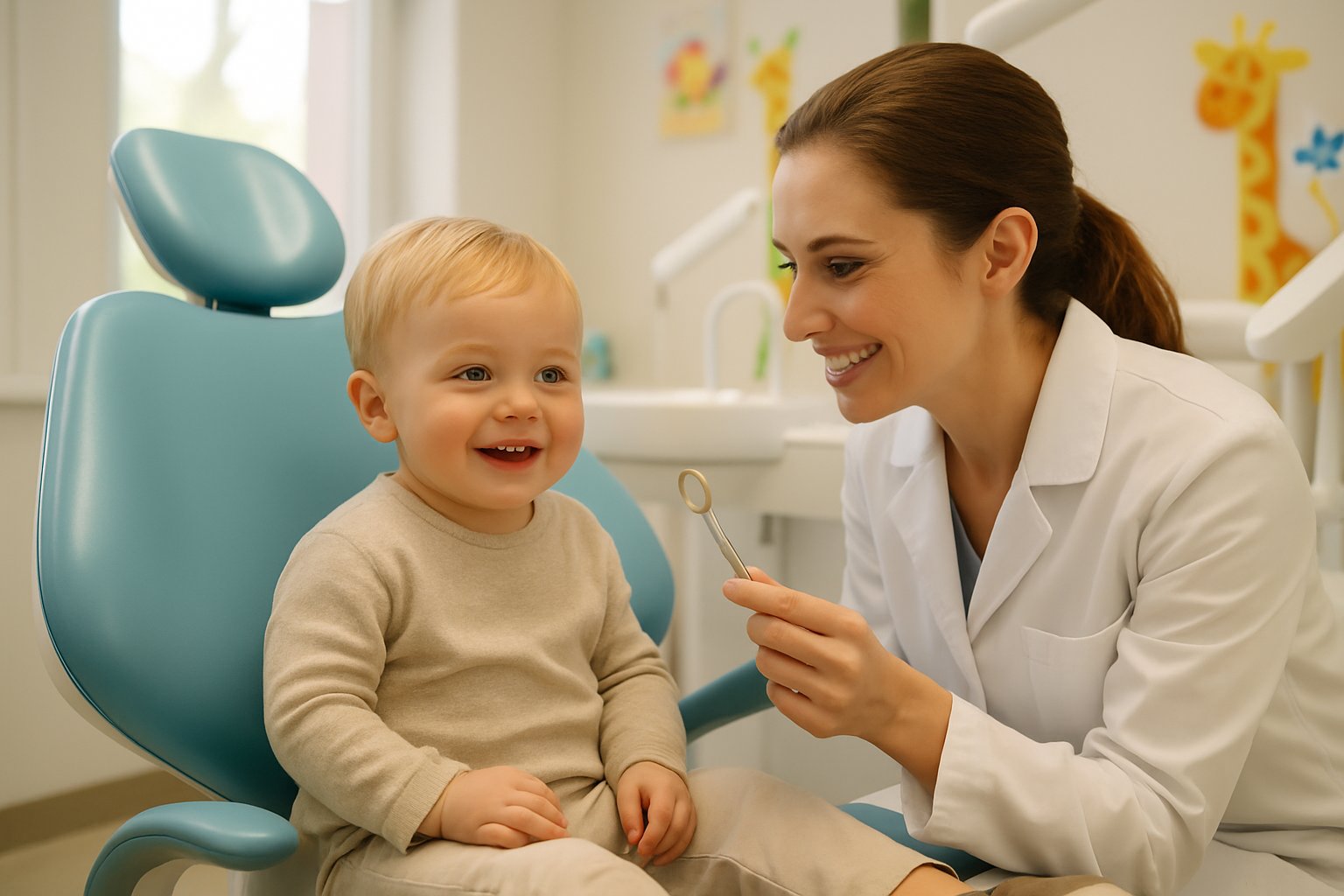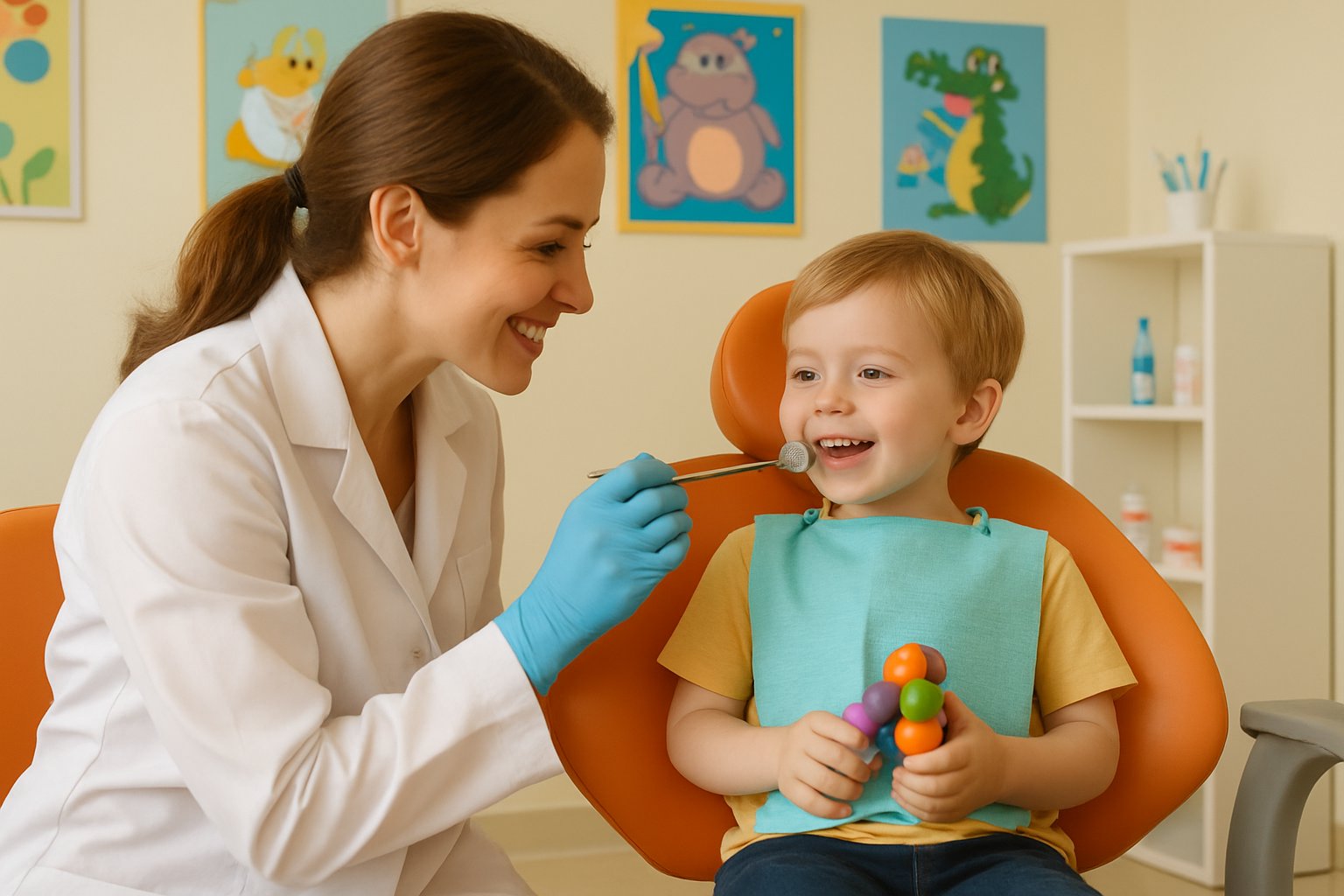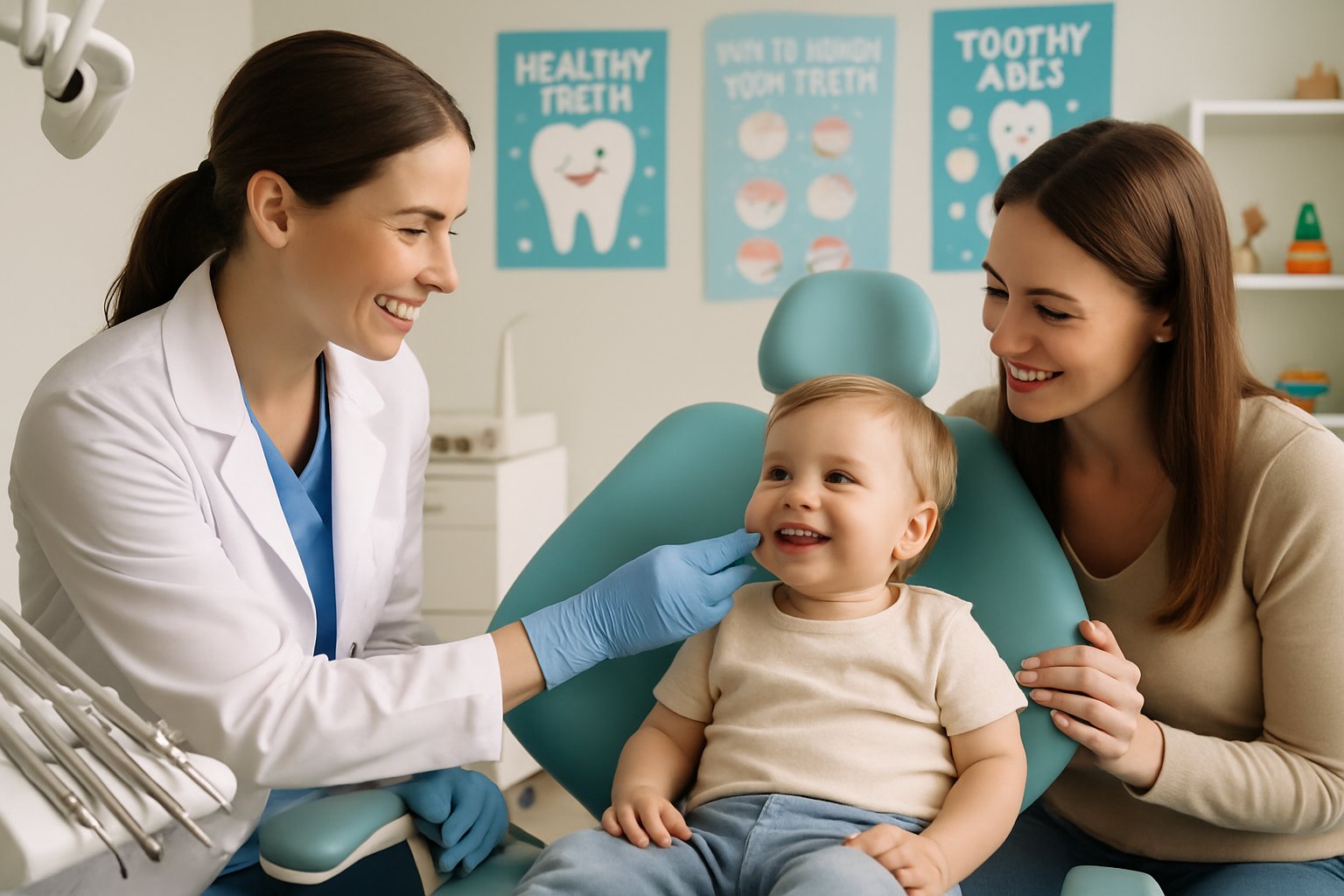When Should My Child Start Seeing a Dentist?
Many parents wonder when to take their child to the dentist for the first time.
The answer is often earlier than most people expect.

Your child should visit a dentist by their first birthday or within six months after their first tooth comes in. This early visit helps catch problems before they get worse.
It also helps your child get used to the dentist’s office.
Starting dental visits early builds good habits for life.
Baby teeth matter because they help with eating, speaking, and saving space for adult teeth.
Key Takeaways
- Schedule your child’s first dental visit by age one or six months after their first tooth appears.
- Early dental visits help prevent problems and make children comfortable with dental care.
- Baby teeth play important roles in eating, speaking, and guiding adult teeth into place.
When to Schedule Your Child’s First Dental Appointment

Most dental experts recommend that children have their first dental visit by age one or within six months of their first tooth appearing.
Early dental visits prevent problems and teach good oral health habits.
Age Recommendations for the First Dental Visit
The “first tooth, first birthday” rule means you should schedule your child’s first dental appointment by their first birthday or within six months after the first tooth comes in.
Most babies get their first tooth between 4 and 7 months old.
If your child’s first tooth appears at 6 months, schedule the appointment by their first birthday.
Some children get teeth earlier or later than average.
Early bloomers who get teeth at 4 months should see a dentist by 10 months.
Late bloomers who don’t get teeth until 10 months can wait until 16 months.
Key dental milestones to watch for:
- First tooth: 4-7 months
- Four front teeth: 8-12 months
- First molars: 13-19 months
- All 20 baby teeth: by age 3
These early dental visits let us track your child’s tooth development.
We can spot problems before they become serious.
Why Early Dental Visits Matter
Baby teeth hold space for permanent teeth and help children speak and eat.
Tooth decay can start as soon as the first tooth appears.
About 23% of children ages 2-5 get cavities in their baby teeth.
Early dental visits help prevent this common problem.
Early visits help us:
- Check for proper tooth development
- Look for early signs of decay
- Teach proper brushing techniques
- Discuss diet and feeding habits
- Apply fluoride if needed
We use these appointments to make dental visits feel normal and fun.
Children who start dental visits early are less likely to develop dental anxiety later.
Signs It’s Time to See a Dentist
Don’t wait for scheduled visits if you notice warning signs.
Some problems need immediate attention to prevent bigger issues.
Schedule an appointment right away if you see:
- White or brown spots on teeth
- Teeth that look chipped or broken
- Pain when your child eats or drinks
- Swollen or bleeding gums
- Bad breath that doesn’t go away
Other signs include loose teeth before age 5 or trouble chewing food.
If your child falls and hits their mouth, call us even if the teeth look fine.
Habits that may need dental attention:
- Thumb sucking after age 3
- Using a pacifier after age 3
- Mouth breathing
- Teeth grinding at night
After the first visit, we usually see children every six months.
This schedule helps us catch problems early and keep teeth healthy as new ones come in.
What to Expect at Your Child’s Initial Dental Visits

The first dental visits introduce your child to the dental office and include basic oral health checks.
We recommend starting these visits by age one or within six months of the first tooth appearing.
Preparing Your Child and Yourself
Talk about the visit in simple, positive words a few days before the appointment.
Avoid scary words like “shot” or “pain.”
Say the dentist will “count your teeth” or “make them sparkle.”
Read children’s books about visiting the dentist.
Many libraries have books that show friendly dentists and happy children.
Schedule the appointment for a time when your child is well-rested and fed.
Morning appointments often work best for young children.
Bring comfort items like a favorite stuffed animal or blanket.
These items help children feel secure.
Stay calm yourself.
Children notice if you feel anxious, so try to stay relaxed.
Arrive early to handle paperwork and let your child get familiar with the office.
Let your child explore the waiting area and see other children having positive experiences.
Typical Procedures During the First Appointment
The pediatric dentist will do a gentle oral examination.
Your child may sit on your lap or in the dental chair.
Tooth counting comes first.
The dentist looks at each tooth and checks how they are coming in.
They also check the gums and tongue.
Cleaning may happen if your child cooperates.
The dentist uses a soft brush or cloth to gently clean the teeth.
Fluoride treatment might be given if your child has several teeth.
This quick step helps prevent cavities.
X-rays are rarely needed at the first visit unless there is a specific problem.
Most children don’t need x-rays until age 4-6.
The dentist will discuss oral health with parents.
They will talk about brushing, teething, and feeding habits that affect teeth.
The visit usually lasts 15-30 minutes.
Short appointments help children avoid feeling overwhelmed.
Building Positive Dental Experiences
Praise your child for cooperating during the checkup.
Even small steps like opening their mouth deserve recognition.
Choose a pediatric dentist who specializes in treating children.
These dentists have special training and kid-friendly offices.
Make dental care fun at home.
Let your child pick their own toothbrush and toothpaste flavors.
Schedule regular visits every six months once your child turns two.
Frequent visits help children get comfortable with dental care.
Stay positive after the appointment.
Tell your child you are proud and share what the dentist said about their teeth.
Address any fears that come up.
If your child seems worried about future visits, talk through their concerns and offer reassurance.
The goal is to make dental visits feel normal and safe.
When children start with positive experiences, they build good oral health habits for life.
Ongoing Pediatric Dental Care and Milestones

Regular dental visits help children keep their teeth and gums healthy as they grow.
We recommend visits every six months and watch for changes as baby teeth fall out and permanent teeth come in.
Follow-Up Visit Schedule
Bring your child for dental checkups every six months after their first visit.
This schedule lets us catch problems early when they are easier to treat.
Some children may need visits every three to four months.
We recommend more frequent visits if your child has cavities, gum problems, or a high risk for tooth decay.
Typical visit schedule:
- Ages 1-3: Every 6 months
- Ages 4-6: Every 6 months
- Ages 7-18: Every 6 months (or more often if needed)
We will let you know if your child needs a different schedule.
Each child’s needs are unique.
Transitioning from Baby Teeth to Permanent Teeth
Baby teeth usually start falling out around age 6.
The first permanent teeth appear at the same time.
Timeline for tooth changes:
- Ages 6-7: First baby teeth fall out, first permanent molars appear
- Ages 7-8: Front teeth (incisors) are replaced
- Ages 9-11: Canine and premolar teeth are replaced
- Ages 12-13: Second permanent molars appear
We watch this process during visits.
Sometimes permanent teeth grow in before baby teeth fall out, which can cause crowding.
The transition period lasts about six years.
We help guide your child through each stage and answer questions about loose or new teeth.
Common Treatments and Preventive Measures
Dental sealants are thin coatings we put on the chewing surfaces of back teeth.
We often recommend sealants for permanent molars to prevent cavities in deep grooves.
Fluoride treatments strengthen tooth enamel.
We may apply fluoride gel or foam during visits for extra protection.
Regular cleanings remove plaque and tartar that brushing and flossing miss.
We also polish teeth and check for early signs of problems.
We teach proper brushing and flossing during visits.
Good home care prevents most dental issues.
Recognizing the Need for Orthodontic Evaluation
We usually recommend an orthodontic evaluation by age 7.
This allows us to spot problems while your child is still growing.
Signs that may indicate orthodontic needs:
- Crowded or crooked teeth
- Large gaps between teeth
- Overbite or underbite
- Difficulty chewing or biting
Early evaluation does not always mean immediate treatment.
We often wait until more permanent teeth appear before starting braces or other treatments.
Some problems are easier to fix during childhood when jaw bones are still developing.
We will refer you to an orthodontist if we see issues that need special care.
Protecting and Supporting Your Child’s Oral Health at Home
Good oral care starts at home with daily habits and smart choices.
We can prevent serious dental problems like baby bottle tooth decay by taking the right steps early.
Establishing Healthy Oral Habits
Start cleaning your baby’s mouth before teeth appear.
Use a soft, damp cloth to wipe their gums after feeding.
Once the first tooth comes in, brush twice daily.
Use a soft-bristled toothbrush made for babies.
For children under 3:
- Use fluoride toothpaste the size of a rice grain
- Brush gently in small circles
- Clean all tooth surfaces
For children 3-6 years old:
- Use a pea-sized amount of fluoride toothpaste
- Help them brush for two minutes
- Make sure they spit out toothpaste
Brush your children’s teeth until they can tie their shoes well.
Most kids need help until age 6 or 7.
Making brushing fun helps build good habits.
Play their favorite song or let them pick a special toothbrush.
Understanding and Preventing Baby Bottle Tooth Decay
Sugary drinks left on teeth too long cause baby bottle tooth decay. These drinks can create serious cavities in young children.
Common causes include:
- Giving babies bottles of milk or juice at bedtime
- Allowing toddlers to carry sippy cups with sweet drinks all day
- Dipping pacifiers in honey or sugar
We can prevent decay with simple changes. Only put your child to bed with a bottle if it contains plain water.
Limit juice to 4 ounces per day for children over 1 year old. Babies under 1 year should not have juice.
Teach toddlers to drink from regular cups by their first birthday. This lowers the time teeth touch sugary liquids.
Clean bottles and sippy cups daily with hot soapy water. Replace them when you see wear or damage.
Partnering with Your Pediatric Dentist
Your pediatric dentist creates the best oral care plan for your child. They understand how teeth and mouths grow and change.
Ask questions during every visit. Your dentist can show you better brushing techniques or suggest helpful products.
Regular cleanings remove plaque you might miss at home. Professional fluoride treatments make teeth stronger against cavities.
Your dentist looks for problems early when they are easier to fix. They can spot issues with tooth development or bite alignment.
Follow their advice about diet and habits. They might suggest limiting certain snacks or drinks that harm teeth.
Call your dentist right away if your child has tooth pain, injury, or unusual mouth problems.
Frequently Asked Questions
Most children should see a dentist by their first birthday or within six months of their first tooth appearing. Children need dental check-ups every six months to keep good oral health.
At what age should a child have their first dental appointment?
Schedule your child’s first dental visit by age one. Do this within six months after their first tooth appears.
Some dentists suggest the visit should happen no later than the child’s first birthday. Early visits help catch problems before they become serious.
Starting dental care early helps your child get used to the dentist’s office. We can teach you how to care for your child’s teeth at home.
How frequently should children have dental check-ups?
Children should visit the dentist every six months for regular check-ups. This schedule helps us spot problems early when they are easier to treat.
Some children may need more frequent visits. We might recommend visits every three to four months if your child has a higher risk for tooth decay.
Your dentist will tell you how often your child should come in. The schedule depends on your child’s oral health needs.
What should parents expect during their child’s first dental visit?
The first visit is usually short and simple. We focus on making your child feel comfortable in our office.
We will examine your child’s teeth and gums gently. We might clean their teeth if they let us.
We’ll talk to you about brushing, flossing, and feeding habits. We’ll also discuss what to expect as more teeth come in.
Your child might sit on your lap during the exam. This helps them feel safe and secure.
Are there specific dental concerns for infants and toddlers?
Baby bottle tooth decay often affects young children. This happens when babies fall asleep with bottles containing milk, juice, or formula.
Thumb sucking is normal for babies and toddlers. Most children stop on their own between ages two and four.
Teething can make babies fussy and cause extra drooling. We can suggest safe ways to help with teething pain.
Early tooth loss from decay or injury can affect how permanent teeth come in. We watch for these issues during check-ups.
How can parents prepare their child for their first dental visit?
Read books about going to the dentist with your child. This helps them know what to expect.
Play pretend dentist at home. Count your child’s teeth and let them brush a stuffed animal’s teeth.
Use positive words when talking about the dentist. Avoid words like “hurt” or “pain” that might scare them.
Bring a comfort item like a favorite toy or blanket. Schedule the visit when your child is well-rested and fed.
What signs indicate it’s time for a child to see a dentist?
White or brown spots on teeth can be early signs of decay. Treat these spots before they turn into cavities.
If your child feels pain when eating or drinking something hot or cold, take notice. Do not ignore tooth pain.
Bleeding gums during brushing can signal gum problems. Healthy gums do not bleed when brushed.
If bad breath stays after brushing, it might mean tooth decay or gum disease. A dentist can find the cause and provide treatment.
📞 Contact Kaufman Dentistry Today
Give us a call at (310) 838-7780 to schedule your appointment and take the first step towards a stunning smile.
You can find us at 10760 Washington Blvd., Culver City, CA 90232. We look forward to welcoming you to our practice and helping you achieve the smile of your dreams!
